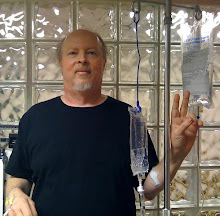skip to main |
skip to sidebar
My third go-around with bendamustine (Treanda) and rituximab is over, with some notably different reactions than before.
The main event involved a 14-hour bout of diarrhea, which began the night of the second bendamustine infusion. I will spare you the details. But it is appropriate here that I say "Thank you" to the makers of Imodium, which I now regard as one of the Ten Wonders of the Modern World, ranking somewhere after the automobile and somewhere before air conditioning.
(FYI, according to the chemo nurses, you can take an Imodium pill every two hours, despite what it says on the box. That schedule proved quite effective.)
Otherwise, Round Three went off without the infusion reaction to Rituxan that characterized the first two rounds, probably because I was premedicated with enough Benadryl, Demerol and Solu-Medrol to bring down a rabid tiger.
Round Three brought some noticeable reduction in abdominal lymph nodes, which I had been hoping to see as the treatments progressed. I am now one loop tighter on my belt. I still have a long way to go in the abdominal nodes department, but this is encouraging. Three more cycles of B&R await me; I am guessing that I won't get a complete remission but I may get as much of a remission as I could have reasonably hoped for.
Blood counts remain decent, with hemoglobin in the 10s and platelets around 110. Dr. Droll says the numbers should go up as the treatment progresses. My absolute lymphocyte count remains laughably low. (UPDATE: As of my Oct. 1 CBC, ALC is 0.9, hemoglobin has risen to 11, and platelets are at 204, the highest they have been in years.)
The post-chemo fatigue and nausea that I wrote about following Round Two were there again, but in milder form. It's Monday, and the last infusion was Wednesday of last week, and I am feeling normal again, or as normal as I get.
Today is the ninth anniversary of my diagnosis with chronic lymphocytic leukemia, after which I will enter my tenth year of fighting this thing.
The date September 3 occupies the same place in my memory as September 11, November 22, and December 7. In other words, it is a date that lives in infamy.
I have some random thoughts today, as I do every time September 3 rolls around.
One is that I am living in what the late CLL expert Dr. Terry Hamblin would have regarded as my end times. People with my type of CLL (unmutated, 11q-deleted, at least up until recently) live about eight to twelve years after diagnosis, he once told me. He had hundreds, if not thousands, of case histories to back up that assertion.
But he told me this back in 2006 or 2007, and fortunately a lot has changed in CLL very quickly. I have been able to take advantage of two new treatments, lenalidomide (Revlimid) and now bendamustine (Treanda). The horizon looks a little bright, what with the kinase inhibitor trials that seem to be keeping CLL in check, as well as the killer T-cell technology that is being developed to, just perhaps, put an end to the disease once and for all. There’s more stuff out there; I can’t keep track of it all. But I do believe that someday in the not-too-distant future, maybe in another nine years, CLL as we know it today will be a highly controllable beast. (And I have no doubt that within the lifetimes of some readers of this blog, it will basically become a curable condition.)
I just have to get from here to there and beat Dr. Hamblin’s odds. There are ways to try to do this. One is to make the best decisions possible, which is never easy. I've made my choices, and unless there is an alternate universe somewhere with another me who chose a different course, there's no way of knowing if I have made the best choices. There is a reason why I keep this quote from Vaclav Havel on the right side of this page: "Hope is not the conviction that something will turn out well, but the
certainty that something makes sense, regardless of how it turns out."
A second factor is the pace of research and development, the degree to which progress in treatment is made, both through dogged determination and strokes of good fortune. In this department, things are moving about as fast as can be hoped.
A third factor is the ultimate one, in my view: Luck.
For all the problems with our medical system, I am lucky to live in the United States, where most of the CLL research and clinical trials of import take place. I am not so lucky to be saddled with bad insurance, but there are ways to get past some of those limitations if one is willing to dig deep enough and be persistent enough. Still, the re-election of Barack Obama may have a direct impact on my life span. The survivability of the Affordable Care Act, which would allow me to purchase much better private insurance in 2014, is a personal thing to me.
More than that, luck has a lot to do with how the disease progresses, what course it takes. We CLLers live forever with the prospect of a shoe dropping somewhere, bringing with it a new and unwelcome challenge. I’ve had my problems this past year, but the current bendamustine-rituximab treatments appear to be giving me a new lease on life, as it were. Where things will be with me in three, six, nine years, I cannot know. I do know that the disease rarely gets better the longer you have it; I also know that new treatments are changing the game.
Playing the game is an inescapable fact of life for those with a chronic disease. After nine long years I feel like a veteran of what Dr. Hamblin once likened to a war of attrition. Another CLL expert, Dr. John Byrd, told me in 2006 that CLL is a long journey.
May yours – and mine – be so long as to see the day when we can live our lives without it.





